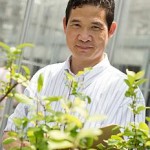Why CRISPR Looks Promising for Apple Breeding
CRISPR/Cas9 (clustered regularly interspaced short palindromic repeats/CRISPR associated-proteins) is the latest precision gene-editing system that allows improvement of crop plants without leaving any foreign DNA behind. To date, the system has been employed successfully in many crop species such as rice, wheat, and tomato.
There are two commonly used approaches for precision gene editing free of foreign DNA. The first is to remove the CRISPR/Cas9 transgene transformed into the genome by genetic segregation in subsequent crosses. The second is to use the purified Cas9 proteins to treat the isolated protoplasts (plant cells with cell walls removed) to achieve gene editing without involving any foreign DNA.
The U.S. federal regulatory agencies, such as USDA’s Animal and Plant Health Inspection Service, have announced that such CRISPR/Cas9 improved crops are equivalent to those developed by conventional breeding. Therefore, they will not be subject to the federal regulations as the conventional transgenic crops are, making the CRISPR/Cas9-based gene editing system a desirable tool for genetic improvement of crop plants.
Apple production has been dominated by a handful of cultivars, such as ‘Gala,’ ‘Red Delicious,’ ‘Fuji,’ ‘Golden Delicious,’ ‘Honeycrisp,’ and others, although there are thousands of named apple cultivars. Given the market recognition of these widely grown cultivars, using the CRISPR/Cas9 system to enhance their fruit quality attributes and resistance to diseases and storage disorders are considered one of the most effective strategies in apple genetic improvement.
Proof of Concept Studies
However, the innate biological characteristics of apple, such as the long juvenile stage before flowering and highly heterozygous genome, make it impossible to use the genetic segregation-based strategy to remove the CRISPR/Cas9 transgene without losing its original identity and years of waiting for flowering and crossing.
In addition, regeneration of apple plants from their protoplasts is extremely difficult, if not impossible. This effectively prevents the CRISPR/Cas9 protein-based gene editing approach from being used in apple.
Given these technical obstacles in apple, the CRISPR/Cas9 based gene editing has mostly been limited to proof of concept studies thus far. For example, the phenotypic marker gene PDS has been a frequent target as knocking out PDS would lead to albino leaves and plants, allowing easy assessing of the gene-editing effect.
Another example is the TFL1 gene, which is known to control the flowering time of plants, including apple. To eliminate the long juvenile phase to accelerate the breeding process in apple, a study successfully targeted the TFL1 gene using the CRISPR/Cas9 system.
The resultant transgenic plants flowered while being cultured in tissue culture jars, demonstrating a great potential of the CRISPR/Cas9 system in gene editing and trait manipulation in apple. An important drawback in these proof of concept studies is the end products of the CRISPR/Cas9-based gene editing carry the CRISPR/Cas9 transgene, i.e., they are still “transgenic,” essentially the same as GMOs (genetically modified organisms) although the target genes were edited successfully.
Reducing Fire Blight
Fire blight is a devastating disease in apple production, and gene MdDIPM4 is known for its essential role in apple’s sensitivity to the disease.
In a recent study, gene MdDIPM4 in the cultivar ‘Golden Delicious’ was edited using the CRISPR/Cas9 system, which significantly reduced its sensitivities to fire blight.
Remarkably, the CRISPR/Cas9 transgene in the fire blight-improved ‘Golden Delicious’ plants was nearly completely removed by a programmed transgene self-elimination strategy, leaving behind a minimal trace of foreign DNA that does not contain any protein coding sequence, promising a practical application of the CRISPR/Cas9-based gene editing in apple disease control.
Outlook
The CRISPR/Cas9-based gene editing is feasible in apple, and its practical applications are doubtlessly promising. However, technical challenges remain in the CRISPR/Cas9-based gene editing in apple, especially when free of any foreign DNA and maintaining the original identity are required.
These challenges could be attributed largely to the inability to deliver effectively the CRISPR/Cas9 molecular machinery into plant cells without genome integration. Lately, various nanoparticles, such as single-walled carbon nanotubes, have been shown capable of delivering DNA into plant cells for transient gene expression.
These advances implicate that using nanocarriers to deliver the CRISPR/Cas9 molecular machinery into apple cells is possible. It is expected that in the near future nanocarriers will enable CRISPR/Cas9-based gene editing without integration of any foreign DNA into the apple genome.










